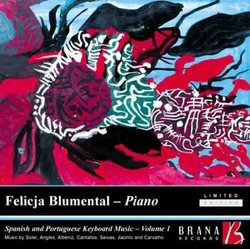| All Artists: Various, Felicja Blumental Title: Spanish and Portuguese Keyboard Music - Volume 1 Members Wishing: 0 Total Copies: 0 Label: Brana Records Release Date: 6/25/2004 Genres: Special Interest, Classical Styles: Opera & Classical Vocal, Forms & Genres, Sonatas, Historical Periods, Baroque (c.1600-1750), Classical (c.1770-1830) Number of Discs: 1 SwapaCD Credits: 1 UPCs: 803680440155, 821158102121 |
Search - Various, Felicja Blumental :: Spanish and Portuguese Keyboard Music - Volume 1
 | Various, Felicja Blumental Spanish and Portuguese Keyboard Music - Volume 1 Genres: Special Interest, Classical
The 18th Century was an eventful time for the religious establishments in Spain and Portugal. Musicians travelled frequently between the countries and the techniques employed by organists and choir masters were shared. As ... more » |
Larger Image |
CD Details
Synopsis
Album Description
The 18th Century was an eventful time for the religious establishments in Spain and Portugal. Musicians travelled frequently between the countries and the techniques employed by organists and choir masters were shared. As a result of this cross-fertilization of ideas, the keyboard techniques evolved. When King Johan V (1707-1750) became ruler of Portugal, he set about cultivating the arts in the city of Lisbon. Institutions were reformed and Portuguese musicians had the opportunity to take apprenticeships in Italy while Italian musicians, such as Domenico Scarlatti were welcomed into Lisbon to perform. Scarlatti in particular, was a central figure at this time, filling the post of Chapel Master in the capital city for 10 years from 1719. Carlos de Seixas (who was Vice Chapel Master) and Frei Jacinto were two of Portugal?s most important musicians during this period. They composed prolifically for the keyboard, particularly sonatas and toccatas. Seixas was credited as having bridged the gap between the Baroque and Classical eras with his Sonatas. Father Antonio Soler, on the other hand, dominated the musical scene in Spain. He was greatly nfluenced by Scarlatti and wrote a technical treatise on modulation. Tragedy occurred in 1755, when an earthquake shook Lisbon and destroyed many of its treasures including libraries containing music manuscripts. Because of this, many compositions by Carlos de Seixas and Frei Jacinto were destroyed. However a few survived that still enjoy exposure today. Here is a handful of wonderful Spanish and Portuguese works that have survived the test of time.

 Track Listings (15) - Disc #1
Track Listings (15) - Disc #1